Banking in darkness – FDIC system insures over $7 trillion in deposits with a dwindling insurance fund. Americans are offered close to zero percent interest rates to stuff their money into this banking vortex.
- 8 Comment
The American banking system is based on pure faith. Usually when the topic comes up in conversation I will ask someone if they know what backs the green cash in their wallet. One of the common responses is “there is gold in Fort Knox†or another typical response is that it is backed by U.S. assets. Unfortunately both of these answers are incorrect. In fact all of our money deposited in the banking system is backed by the pure faith in our U.S. government. Now for decades this implicit belief was fine because we actually were a creditor and exporter nation. We also had a higher savings rate. Today we have a system where we continually spend more than we produce and expect this dynamic to somehow function long term as if we found an endless well of Kool-Aid. The Federal Deposit Insurance Corporation (FDIC) insures each individual account up to $250,000. Given that one in three Americans has zero dollars to their name and most others have a sum nowhere close to this amount, many go forward with an unstated faith in the system. However the FDIC Deposit Insurance Fund is largely running on fumes. This shouldn’t be such a big issue aside from the fact that the American banking system has over $7 trillion in deposits.
FDIC Fund taking hits
Source:Â Â The Tree of Liberty
The interesting thing to note is that bank failures have slowed down yet the FDIC is actually benefitting from the Federal Reserve’s massive quantitative easing adventure. Banks have been allowed to step up to the plate and borrow from the Fed at ridiculously low rates to remedy their own appalling balance sheets. Yet little of this has helped working and middle class Americans. It is also worth mentioning that the banks with the ugliest balance sheets are the too big to fail and we have already been told that they will not fail even if we have to increase the Fed balance sheet to $2.7 trillion in a colorful trail mix of junk loans. These banks have grown over the problematic decade:
Bank of American and JP Morgan Chase each have $2 trillion worth of assets each. Most of the troubled balance sheets are situated in a handful of banks even though collectively the U.S. has over 7,500 banks. The top 10 virtually dominate the $13 trillion in total assets:
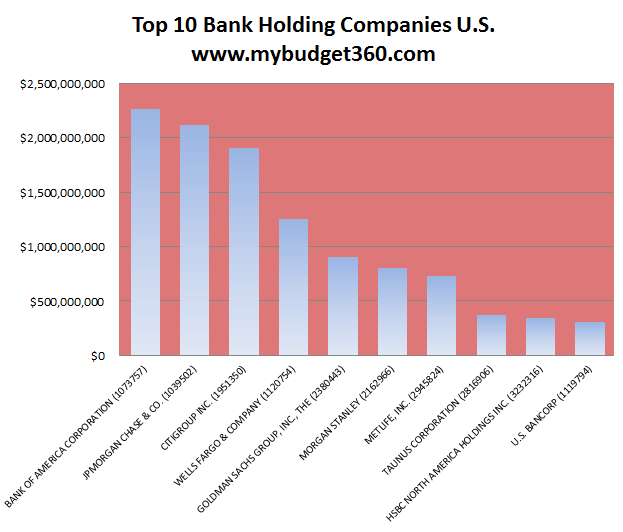
Now you have to draw your own conclusions here. The biggest banks with the worst balance sheets have a mandate that they will not fail. What this means is the cost of the bailouts is being supported by the public via low savings rates and also hidden inflation:
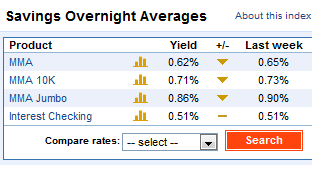
Keep in mind the above rate is for larger accounts. Most working and middle class Americans simply have enough in their banking account to pay the monthly bills and maybe fill up their car with low octane $4 a gallon fuel. As food and energy costs rise a larger portion of monthly income is being devoted to these items thanks to the Federal Reserve bailing out these too big to fail banks. This is ultimately the cost of not letting bad banks fail and allowing good banks to grow. The cost indirectly shows up and is spread across the mainland of America.
Even in light of the pathetically low savings rate, many Americans have increased their savings rate because access to debt has been slowed down:
Of course increasing your savings rate from zero makes anything look significant. Two main drivers for the above trend; first, Americans are being pushed to save because access to debt via home equity or credit cards is being shut off and second, many simply do not trust the casino that is known as Wall Street. You know things are bad when big time Vegas gamblers state publicly that they don’t trust Wall Street. This push is being reflected above and the increase has occurred at a time when many of the big banks are simply offering a place similar to your mattress to store your money and a rate of interest that is slightly above zero (also similar to your mattress).
The employment picture and banking implications
The good news is that we have added jobs in the last few months. The bad news is these jobs are reflecting the new world of low wage capitalism. In other words we have lost many good paying higher wage jobs and have replaced them with lower paying jobs. All this is happening while the cost of many items is rising. So you can do the math here; less pay and rising expenses. This calculus is not good for the American worker. If anything it is showing that our economy is adjusting to this new reality where bailed out banks can pay CEOs 800 times the median household income for actually driving our economy into the ground. I think as Americans we rally around innovative companies that produce a good and reward those that provide a service. Yet most of the large payouts are going to Wall Street investment banks that are nothing more than swindlers and snake oil salesmen trying to siphon off economic rents from the productive economy. Reward production and economic growth, not scandalous cronies that exist only because they have mastered the art of graft.
The clearest picture of this new economic divide shows up in the average per capita income:
Source:Â Social Security Administration
I find it amazing that few realize that half of all workers make on average $25,000 a year or less. That is, one out of two working Americans makes the equivalent of one Ford car per year (or half a year of tuition at a private university). There is something seriously awry with our banking system because it does not support the greater good of our economy. As things stand we will live in a casino like environment were massive bubbles will appear in random sectors like housing, technology, energy, commodities, and higher education simply because we allow this symbiotic relationship between Wall Street and our government to persist. The real scandal is happening there and this is what will bring the end to the middle class.
So what do we need to do? What needs to be called for is the splitting up between Wall Street investment banking and regular deposit institutions. How is it possible that we have a FDIC with nearly no money in their insurance fund backing up $7 trillion in deposits? Not only is that hard to believe but these banks have over $13 trillion in assets while massively speculating in global stock markets. If these institutions want to gamble with their own money so be it but expect them to fail. Working and middle class Americans need to rally around the nucleus of the problem and demand real substantive change. The Federal Reserve cannot balloon its balance sheet to $2.7 trillion and impact our money supply without allowing for a deep and thorough audit. If change does not occur we are going to end up with a Wal-Mart and McJob economy with people moonlighting at questionable for profit institutions that teach you a hard lesson in student loan debt all the while banks count their profits after booting out millions of Americans via foreclosure thanks to taxpayer bailouts. With this kind of system you might as well bank with the lights out.
If you enjoyed this post click here to subscribe to a complete feed and stay up to date with today’s challenging market!8 Comments on this post
Trackbacks
-
peter said:
If you check out history what is happening today is no different than any other period of time when the govt. overspent. The Govt. then cheapens its currency to reduce its obligations and then eventually go bust. We are racing in that direction. Thanks first to are crooked Govt. Than next to the Fed. Res. and Lastly to our multinationals. Its all about Greed but the bad kind of greed that for your own benefit to accumulate wealth or power you are willing to see your fellow man suffer. The problem we face today can be largely blame on the congress and pres. woodrow wilson who in 1913 created the progressive tax system, lobbyist, and last but not least the Fed. Res. the end!
May 7th, 2011 at 5:53 am -
mike bedell said:
Thank you for your accurate reporting. I read the book “The Creature from Jekyll Island a Second Look at the Federal Reserve” before 911 and it reads like a football play book for what has happened to our economy and government. This is by design according to the book and it is the fall of the Roman Empire all over again.
May 7th, 2011 at 6:04 am -
MattS said:
The FDIC limits are a moving target; they keep changing the terms.
It used to be you were covered to $100K per account, then it was $250K but that was the total of all accounts in single bank. With mergers and acquisitions, you might be screwed if two of your banks merge. In any event I no longer understand how much coverage I have, AND WHEN IT ENDS. I was told it goes back down to $100K on December 31st.But looking at the list of the “big banks” I’m not surprised that Goldman Sachs is listed. One of the perversions of the bailout in ’08 was that Goldman and other brokerage houses were persuaded to apply for bank status so they could get government handouts. Now “Investment Bankers” used to be betting parlors (with your money and consent) and shylockian deal makers, but with their acceptance by the government, in record time, of their status as banks, that gave them direct access to the government bailout funds they now gamble with depositors’ money.
The looting by the banking industry was so blatant and large, that the Fed covered up another $2 trillion in secret loans made outside the very public $800 million that eventually received Congressional approval. Only a FOIA lawsuit by Bloomberg News resulted in the release of the list of recipients, and half or so were overseas banks and businesses. Basically, the Fed lent money to anybody and everything that applied, making new friends along the way.
Our whole financial system is a house of cards (maybe it always was, I don’t know), and the people responsible should be punished.
May 11th, 2011 at 11:02 am -
Matt said:
The FDIC coverage you mention is not right, or if right, will drop to the previous level of $100K in the not-too-distant future. You are particularly vulnerable if you have accounts in banks that merge since your protection is capped. The FDIC coverage is a moving target, as it changes from time to time.
The ’08 bailout of $800MM was a very public fight in the halls of Congress to mask several important private actions that the Fed didn’t want known.
First they gave bank status to brokerage houses (JPM, Goldman, etc.) so the could apply for bailout money, and secondly, the Fed then lent ANOTHER $2Trillion secretly to their friends around the world. It took a two-year legal struggle to get those names released. Companies and banks at home and abroad received loans whether need or not. Basically it was designed to buy friends and influence. It wouldn’t be so bad, but it was our money.
Should brokerage houses which basically gamble with your money (with your consent) be treated the same as banks?
May 11th, 2011 at 11:31 am -
GardenSERF said:
Money backed by faith…and we all should know what will happen when faith is in short supply.
May 11th, 2011 at 12:51 pm -
F. Michael Tuohey said:
Bribery by the oligarchs corrupts the government to act in support of the oligarchs and not in the interest of the vast majority of citizens. Oligarchs power skyrockets. Vast majority of citizens power plummets. Republic fails. Criminal oligarchy stumbles into darkness.
May 12th, 2011 at 8:19 am -
b. ohara said:
?
Profs say ” W. gov s borrow 2 pay interest only.
no way to pay prin. U .. s
total pub pvt debts $199t. two hundred trillion (tom)
gdp u s $ 1 4 t/ yr, debt 13x gdp”May 23rd, 2011 at 10:44 am -
Joe Smith said:
People are not incorrect in saying our currency is backed by “US assets.” Our currency is backed mainly by US Treasuries, so technically the currency is, in fact, backed by “US assets.” (Yes, Treasuries are, in turn, backed by faith in the US Government to levy taxes on the goods and services produced by Americans in order to make good on its debt, but Treasuries are still an asset, nonetheless.)
June 1st, 2011 at 8:24 pm
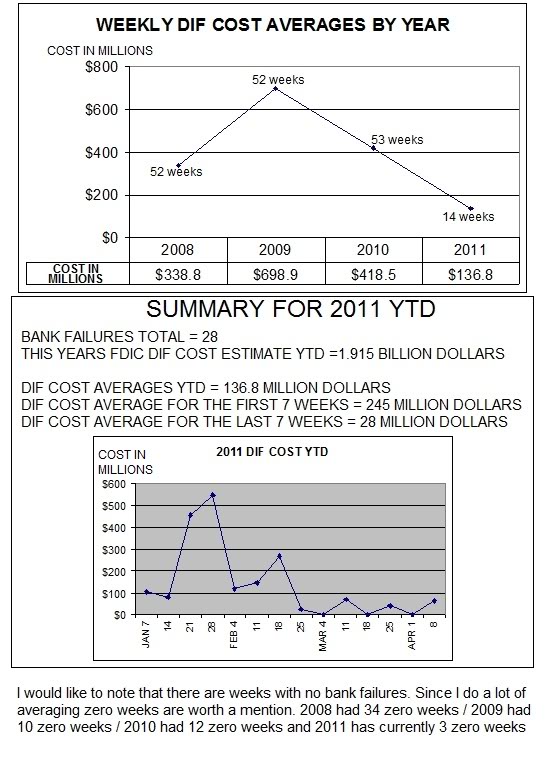
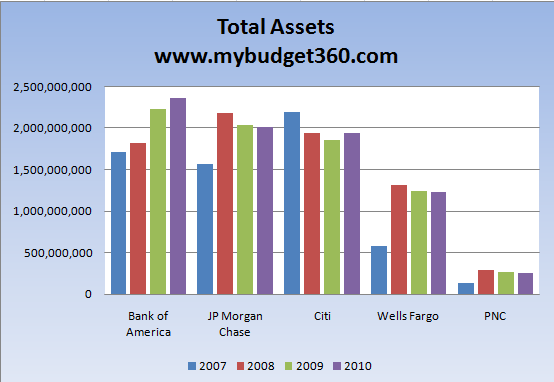
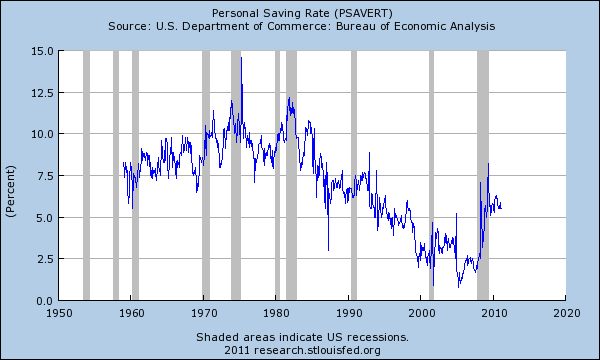
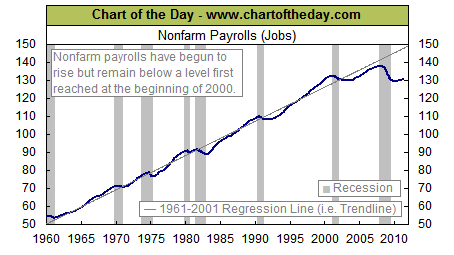
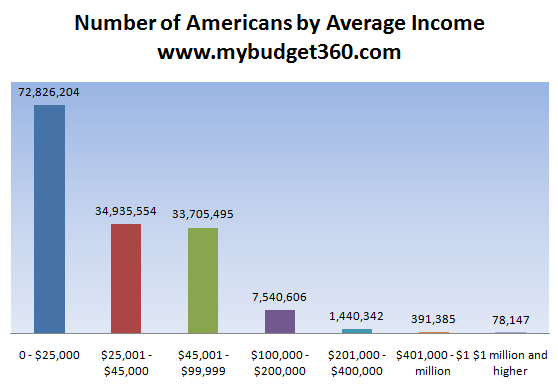
 If you enjoyed this post click here to subscribe to a complete feed and stay up to date with today’s challenging market!
If you enjoyed this post click here to subscribe to a complete feed and stay up to date with today’s challenging market!